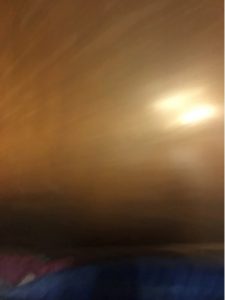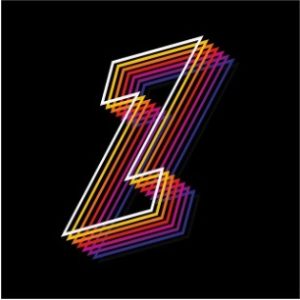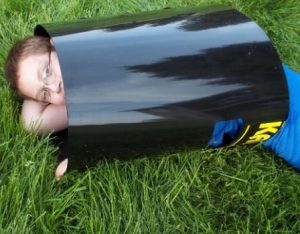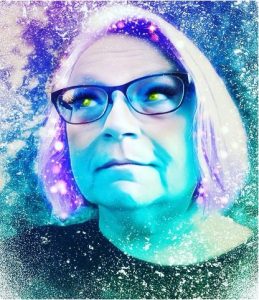“Gatherer’s Blog” is an invited feature that provides emergent as well as seasoned writers with opportunities to reflect upon aspects of their own writing processes.
Mutant Mother Missives & Musings: From a “Burning Question” to the Micro Mutant (Memoir) Postcard Project and Beyond
Rachael A. Zubal-Ruggieri

Micro Mutant Postcard #255
(listen to the poem, read by the author)
How do I share my Mutant existence with any Mad detail through a mere 45 words? Seems I’ll simply have to depend on commas to span years, italics to emphasize vain vagaries, and dashes—to imagine if I may even have a future at all.
Image description/alt text: a blurry picture of my son’s darkened bedroom with light reflecting off an off-white ceiling and a teal blanket on his bed in the foreground.
My current writing endeavor, the “Micro Mutant (Memoir) Postcard” (or, MMP) project, grew out of a range of presentations, coursework, and writing workshops, all undertaken as I pursued a degree and sought creative ways to debunk and disrupt traditional representations of “the autism mom.” The project is closely intertwined with my overall narrative, my “origin story.”
In a creative nonfiction course I took with the late Prof. Minnie-Bruce Pratt, we had a complex series of writing exercises with responses and prompts thoroughly embedded within them. In response to one prompt (to use an “unusual multimedia form in contemporary life”), I deconstructed portions of a bookmark I brought home that detailed the “Red Flags of Autism Spectrum Disorders.” Not only did I deconstruct them, I refuted them, using my own examples. One such argument was:
“Lack of appropriate eye gaze” — My son makes plenty of eye contact, but is it the end of the world if your child doesn’t make direct eye contact? I find eye contact a painful sensory experience.
This was only the beginning. The exercises and writing I completed at the time were just one of many sparks, of my neurons firing, lighting up my neurodivergent brain. During this time, I was endeavoring to be much more creative in describing and further defining “who I am”; in fact, I took several separate writing pieces for this course, and mixed and merged them, which I posted online.

Micro Mutant Postcard #81
(listen to the poem, read by the author)
Magneto, I’ve finally discovered what you’ve been trying to teach me. Gamma werewolves are mates worthy of Mad love. Gimpy ties bind me too tightly. My mother’s memory doesn’t suit my need for dynamic Crip narratives. Excelsior, onward; liberation power plays need much better branding.
Image description/alt text: an artistic logo featuring the letter Z in layers of white, yellow, gold, red, violet, purple, and navy blue on a black background, appearing like an neon sign. Image by Modern-Horizon from Pixabay. Free for use under the Pixabay Content License
From #CripCon to #MM(M)Ps
In 2013, Diane R. Wiener and I created and convened the first ever “Cripping” the Comic Con, where another part of my origin story came to light. I knew that a clarification, an origin story reboot, was likely overdue. And of course, everyone has an origin story, right? Why not begin by pivoting away from (or adding to) my origin story as the mother of an Autistic child? Why not write more about me? As I was conceptualizing the MM(M)Ps, and before they came to fruition, I wrote a new “episode.” It appears here (slightly edited):
Due to my love of comics, and my incessant need to analyze and recognize representations of disability within them, I began to think of how every hero in comics has an origin story, from X-Men to Bruce Wayne to Multiple Man; the story of when superpowers (or heroic identities) emerged, when their identity came to be. So, where does my origin story begin?
One branch of my origin story began in childhood, when our family traveled from our rural home outside of Ithaca, NY, to a little Catskills-region town, Downsville, NY, to visit family friends. This family had a household of all boys older than I was at the time. My older sister was often absent during these trips, due to Girl Scout camp, band camp, or some other thing, so I was the only girl there. As my older brother, and all the boys, simply did not wish to deal with me, the baby sister, I had to find ways to entertain myself. I didn’t mind the solitude, but still, I was bored. I discovered plenty of things to keep me occupied (which cemented my mutant superpowers) in the household’s upstairs cupboard full of ‘60s and ‘70s era comic books: Fantastic Four, Avengers, and, most interesting of all, The Tomb of Dracula. This was all well before the time of cable TV, smart phones, and gaming consoles. I now recognize this as a “spark” that not only helped me manage the situation (being the youngest, the only girl most of the time, and isolated), this was the start of my mutancy, but I just didn’t know it yet.
I’ve long had a fascination with postcards, cards of all kinds. Tarot cards, playing cards, business cards, Pinterest, card-based design, and much more, including a multitude of memes. So, during the pandemic, I enrolled in an online workshop, “Postcard Poems.” While I didn’t really work on my mutant postcards during this workshop, participation in this workshop was yet another flaming mutant “mote.” I became fire. And by then I had already turned much of my origin story reboot into snippets—short, constrictive prose fragments. Many of these fragments purposely included alternatives to “normative” grammar and syntax. I used this unconventional form of writing as a mechanism to meet the challenge of my own self-imposed 45-word limit—borrowed from the late Minnie-Bruce Pratt—and one of the writing exercises from the class discussed above:
Select a photograph that you might upload to your (real or imaginary) Flickr account. Use the conceptual tool of “boxing” parts of the photo to create an interactive CNF narrative—writing snippets of story to be placed in text boxes over specific locations in the photograph. …Explore your burning question.1 Here’s the challenge: each box can have only 45 words (emphasis added).
For this exercise, I used the same “unusual multimedia form” exercise I mentioned earlier, but paired more refutations with imagery. I thought: What better way to demonstrate a concept than to match the sentiment with images? I took a few more “red flags” and used pictures of my son to complement my contrarian response. One example:

”A child with autism may have unusual reactions to the way things smell, taste, look, sound or feel.”
Jimmy played KanJam at this picnic, but then experienced it differently with touch. He was like a dog rolling in dirt, resulting in a pleasing sensory experience.
Image description/alt text: A young boy wearing glasses lies on a grassy lawn, peeking out from inside a wide, black shiny vinyl KanJam tube.
A new spark thus arose since that original “burning question.” And where did that ember land? The mechanisms I wrote with, and my dendrites, became engulfed. The word associations excited me. Such fiery connections will make future appearances, for sure.
But even before I enrolled in the Postcard Poetry workshop, I was writing postcards, which I had tentatively named “Micro Memoir Mutant Postcards.” In fact, as of December 2020, I already had 16 drafted (sans imagery). I wrote them without any grammatical sense and, shit, they just flew out of my brain. Not long after, I began selecting photos/pictures to go with each of them. I considered these a “set” and knew I wanted to write more.

Micro Mutant Memoir Postcard #2
(listen to the poem, read by the author)
We all have origin stories. We have those cathartic moments when our powers first emerge. We change. Struggle. Endure. We grow even more powerful. Embracing less recognizable identities adds to the proverbial skewed but foundational Crip woodpile. Gaga or not, I was born this way.
Image description/alt text: Stylized filtered selfie photograph of the author wearing glasses; they have twinkling purple hair and glowing lime green eyes, with an aura of purple and teal sparks floating around them. The author is looking skyward to the right off the screen and is slightly smirking.
Naming Conventions and I’ll #JustKeepWriting
As I’ve previously shared, this project is an ongoing endeavor seeking to meld poetry, confessions, memoir, and imagery with pop culture, especially comic books, and identity, including disability, using specific conventions to bring forth creativity and explore intersections I have not perhaps not yet publicly revealed. Some postcards are memoir, others manifestos, and many are confessional, either addressed to pop culture figures and characters or written as self-revelations and larger “burning” or rhetorical life questions.
Discussing the MMP project connects with my thinking about future work, including the likelihood that I’ll write a memoir, tentatively titled Mutant Mother Musings. This emergent project, a continuation of the current work, would combine different creative writing forms I’ve used over the years. The naming could essentially “mutate,” at any time, but still, the name, the label, the identification has meaning, whether it’s the title of what I’m writing or my own identity. The confidence I feel with these titles, these labels, encourages me to write more. I’ve already written 288 MMPs, so each propels me forward to write more in quantity and duration.
Note:
- As defined on the course syllabus, a “burning question” is something one might ardently seek to understand, an idea looming in their lives, using creative nonfiction to do so. My “burning question”? Before the class even began, I started looking at autistic rhetoric; I wanted to explore my own motherhood—can’t I be “just a mom”? At the time, I thought maybe this class would become a less bitter pill to swallow (or rather the boot in the butt) that I needed to explore these subjects. The class became an impetus for much more.
Read Rachael’s reviews of Disabled People Transforming Media Culture for a More Inclusive World and Season 1: Iris and the Crew Tear through Space!; their essay, “How X-Men’s Beast is My Kindred Spirit, or How I Really Need to Reclaim Blue”; and two more of the Micro Mutant Postcard poems in this issue of Wordgathering.
Back to Top of Page | Back to Volume 18, Issue 1 – Summer 2024
About the Author
Rachael A. Zubal-Ruggieri (she/her/hers, they/them/theirs) is a long-time employee at Syracuse University. She co-created (with Diane R. Wiener) “Cripping” the Comic Con, the first of its kind interdisciplinary and international symposium on disability and popular culture, previously held at SU. At conferences and as a guest lecturer for many years, Rachael has presented on the X-Men comic books, popular culture, and disability rights and identities from her perspective as a Neurodivergent person and as a Mad Queer Crip. Entries in their “Micro Mutant Postcard Project” have been published in Wordgathering: A Journal of Disability Poetry and Literature and Stone of Madness. Their most recent publications include two articles (co-authored with Diane R. Wiener) in the Journal of Literary & Cultural Disability Studies‘ Special Issue, “Cripping Graphic Medicine I: Negotiating Empathy and the Lived Experiences of Disability in and through Comics” (Volume 17, Issue 3).